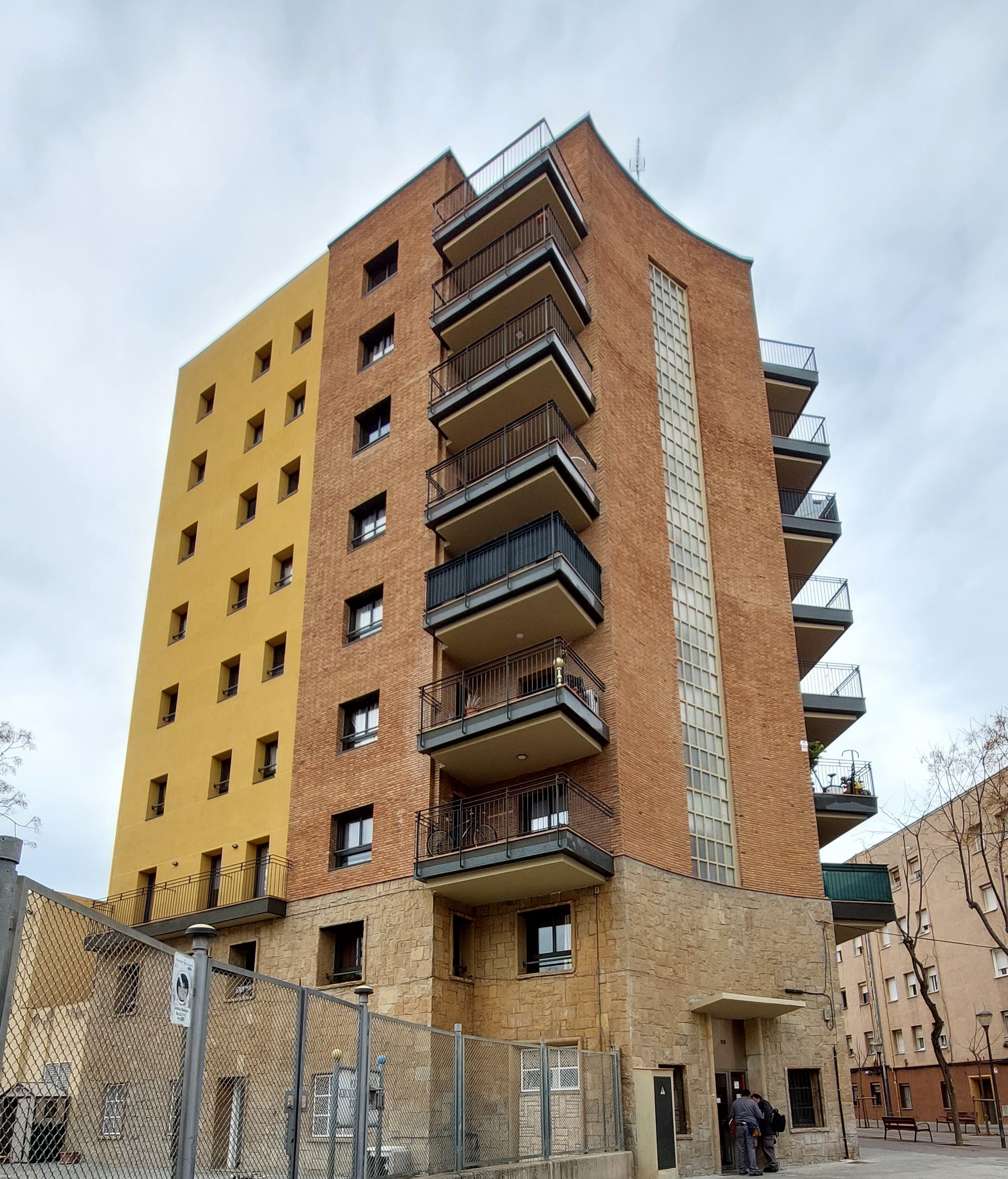
HOUSEFUL: Els Mestres, Sabadell
Created on 12-03-2025
Innovative Aspects of the Housing Design/Building:
Bloc Els Mestres underwent a major retrofit as part of the EU-funded HOUSEFUL project, integrating innovative circular solutions and services. Tenants were involved through technical systems operation learning and feedback sessions. Tenant engagement methods included interviews and workshops focused on teaching residents how to engage with energy consumption and learning the energy consumption of home systems. As with typical DER, there were four main technical improvements to the building: (1) airtightness, (2) insulation, (3) smart systems, and (4) renewable energies. Circular solutions also incorporated into the retrofit to reduce waste include: (1) reusing the balcony balustrades after raising their height to meet building regulations, (2) recycled wall cladding product, and (3) greywater to be treated using the Nature Based Solution (NBS) of a green wall inside the courtyard.
Construction Characteristics, Materials, and Processes:
After the rehabilitation, the housing block has evolved into a resilient structure with two four-bedroom apartments per floor, spanning the 1st to the 8th floor. Its distinctive design encompasses an array of materials, from natural limestone and cork SATE for insulation to yellow render, terracotta brick, and unobstructed glass panels. With a strategic south-east orientation, the building optimizes natural light, thanks to square windows and cantilevered balconies. Inside, the apartments are designed in a clean, white palette, giving tenants the freedom to infuse their unique style and personal touch.
Energy Performance Characteristics:
Physical deep energy retrofit interventions included: cork external wall insulation; airtightness, fixing holes and fissures, double glazing, and other solutions to reduce thermal coefficient; mechanical ventilation; hydraulic balance valve with differential pressure measurement for the determination of the circulation flow, with insulation; and solar thermal panels, owned by the building owner, together increasing energy efficiency by approximately 50% compared to pre-retrofit. Tenants received technical training on how to use dwelling systems, potentially improving energy efficiency.
Involvement of Users and Other Stakeholders:
The rehabilitation process has involved collaborative decision-making among key stakeholders: LEITAT, non-profit organisation managing and researching sustainable technologies—project co-ordinators; AHC—Housing Agency of Catalonia and building owners; Sabadell Council; WE&B, organised co-creation activities and resident outreach; Housing Europe; members of the tenants’ association; Aiguasol, solar thermal energy; and ITEC, Catalan Institute of Construction and Technology—performed LCAs (life cycle analyses) to decide on cost-effectiveness of circular solutions.
The retrofit project encompassed low levels of tenant consultation and feedback sessions. The importance of managing conflicts that arise during tenant involvement in decision-making processes was recognised. A 'circularity agent' was proposed to teach tenants how to use complex technical systems, potentially fostering in-house expertise.
Relationship to Urban Environment:
Located in Sabadell Sud near the local airport, the block has undergone a significant transformation over the years. It has evolved from an isolated building, the once surrounding fields now transformed into a densely populated urban environment. Notably, it seamlessly integrates into this urban landscape, with a tonally harmonious façade that bathes the surroundings in a warm and visually appealing ambiance. The ground floor is dedicated to the community, fostering a strong connection to the local area and its residents. The nearby pedestrianized streets, adorned with benches, trees, and versatile playground equipment for all age groups, create a welcoming and inclusive atmosphere. This building plays a vital role as it provides accommodation exclusively for social housing residents, contributing to the rich social fabric of the urban community.
S.Furman. ESR2
Read more
->
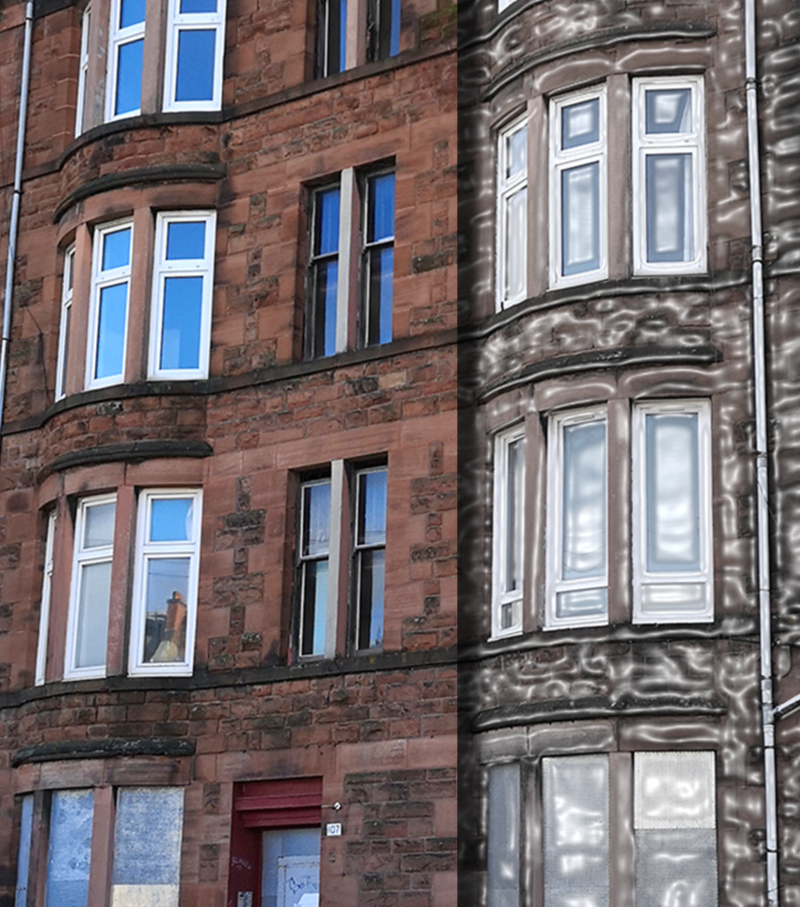
Pre-1919 Niddrie Road Retrofit – An Example of Care for Climate and Health
Created on 15-11-2024
The term 'retrofit' remains a subject of debate, often used interchangeably with 'refurbishment' and 'renovation', lacking a clear distinction. Linguistically, the Oxford English Dictionary (2023) defines 'retrofit' as:
"A modification made to a product or structure to incorporate changes and developments introduced since manufacture or construction; the action or fact of modifying a product or structure in this manner. Also figurative. Concerning buildings, in later use, often implying (an instance of) the making of adaptations to improve energy efficiency or to counteract or mitigate the effects of climate change."
For buildings, retrofit encompasses substantial physical modifications made to them. These changes can stem from two kinds of activities: mitigating activities aimed at improving energy efficiency and adaptive activities, often referred to as 'adaption', involving interventions such as adjustments, reuse or upgrades to align the building with new requirements or conditions (Dixon, 2014).
The retrofitting process of this old tenement at 107 Niddrie Road involved activities for various purposes. For instance, external activities included preserving the aesthetic appearance and heritage of Glasgow's iconic housing typology. The internal activities included repairing all services, including urgent maintenance for timber elements and structural enhancements for future residents' safety.
The retrofitting decisions were also made as a response to the pressing demands of climate change and the future needs of residents. However, these decisions were primarily based on the expertise of the landlord (the housing association), architects, and the Passivhaus enerPHit standard rather than the active involvement of the future occupants (see RE-DWELL blogpost Retrofit and Social Engagement).
In this case study, we will only focus on three primary goals of the retrofitting process: low energy consumption, low carbon emissions, and ensuring the health and wellbeing of future dwellers.
Low energy consumption
The 107 Niddrie Road is an example of how to tackle fuel poverty among dwellers living in this type of historic housing stock. In Scotland, approximately 30% of families living in traditional tenements (equivalent to 175,000 homes) are considered to be fuel poor. The substandard housing conditions of old tenements make it challenging to maintain indoor warmth. Consequently, a substantial portion of a family's income is allocated to energy bills, exacerbating fuel poverty.
The retrofit involved implementing several energy measures aligned with the Passivhaus enerPhit standard to enhance the tenement's energy efficiency. The architects of John Gilbert expect these measures to result in slashing heating costs by up to 90%. Therefore, this retrofit can be considered a deep energy retrofit. Deep energy retrofit provides up to 60 % energy savings by upgrading the building using "a combination or "package" of multiple energy measures that upgrade the physical fabric, heat generation system and lighting of a building" (Page 3, Saffari & Beagon, 2022). The adopted energy measures for this deep energy retrofit included:
1) Retrofitting the fabric: It involved insulating walls, roof, and ground floor, installing triple-glazed windows, and ensuring airtightness to minimise thermal bridging. The retrofit also guaranteed a continuous airtightness line, including all key junctions at the attic level, windows, and doors.
2) Use of Waste Water Heat Recovery (WWHR) system: This system heats cold water using heat recovered from shower or bath drain water. This method significantly reduces hot water costs and carbon emissions by approximately 40%. Given that heating water represents the second largest cost of a fuel bill, this system is expected to substantially reduce these costs and carbon emissions.
3) Individual Air Source Heat Pumps (ASHP): These units were installed in the four flats on the lower floors. In parallel, efficient combi gas boilers were set up in the remaining flats to compare their performance with ASHP during residents' occupancy.
Low carbon emissions
Various measures, including the installation of ASHP and WWHR systems and the utilisation of natural materials, were implemented in a bid to reduce carbon emissions and combat climate change. The project minimised its environmental impact using fewer new materials than new construction blocks. The UK Collaborative Centre for Housing Evidence is currently evaluating the extent of the carbon reduction achieved through these measures.
Ensuring health and wellbeing
By adopting the Passivhaus enerPHit standard, the project prioritised occupant comfort, indoor air quality, and energy efficiency. Expected benefits include:
1) Thermal comfort and reduced energy costs: The retrofit project aimed to maintain warmth during winter and coolness in summer, thereby reducing energy costs, improving residents' quality of life, and minimising temperature-related stress amid rising energy expenses and extreme temperature fluctuations.
2) Damp and mould mitigation for indoor air quality: Condensation and humid air are common issues in Scottish homes, often leading to dampness and mould, adversely affecting residents' health. The project implemented the following techniques to mitigate these risks:
Improving ventilation: A high-performance Mechanical Ventilation Heat Recovery (MVHR) system was installed to provide constant fresh air while extracting humidity. Contrary to a common misconception that installing MVHR eliminates the need to open windows, it is possible to do so in moderation, particularly during extreme temperatures, to conserve energy.
Ensuring air tightness: Thermal bridges, which leak heat during winter and create cold spots on walls, were eliminated. The retrofit assured continuous airtightness line.
Using breathable materials: Lime plaster was used for airtightness and vapour-permeable wood fibre for insulation. These materials mitigate common moisture-related risks in highly airtight buildings.
3) Reduced toxicity of materials for indoor air quality: Efforts were made to minimise indoor air pollution by opting for natural building materials wherever feasible. These materials were chosen to uphold excellent indoor air quality and reduce low-level toxins that could exacerbate health problems, especially for vulnerable individuals. Additionally, chemical treatments on wood were avoided to limit exposure to harmful substances and reduce costs.
4) Altered layout for better functionality and accessibility: Major changes were made to make dwellings more functional for households and guests. Some of the changes contributed to optimising available space, demonstrating the adaptability of the existing property. These adjustments aimed to improve accessibility while complying with current building regulations. A comparison of the before and after floor plan images reveals two main differences. Firstly, the kitchen was relocated closer to the living room area; it was distant and only accessible through the bedroom, making it impractical. Secondly, the bathroom was redesigned to accommodate a spacious shower, and the toilet was moved from the end of a long and narrow corridor. This change ensured accessibility, especially for family members using a wheelchair.
5) Preserve the tenement heritage: The street-facing facade was internally insulated, ensuring the building's historic appearance was preserved. Additionally, triple-glazed windows were carefully chosen to keep the traditional window frame design.
Replicating this retrofitting process on a large scale
The retrofit project at 107 Niddrie Road represents a noteworthy example of successfully implementing the Passivhaus enerPHit standard for deep retrofitting old tenements. The retrofit incorporated a range of energy efficiency techniques, including enhanced ventilation systems and the use of natural, non-toxic materials. However, replicating these retrofits on a larger scale presents some advantages and challenges. For instance, retrofitting several tenements at once could offer the financial benefit of bulk purchasing advanced energy-efficient technologies, like heat pumps, potentially reducing overall costs.
However, the social factor of the dwellers poses a challenge in replicating these projects on a larger scale, mainly when dealing with multiple tenements being retrofitted simultaneously.
Minimising disruptions to residents' daily lives during work is imperative to ensure the success of building retrofitting. In inhabited properties, resident cooperation becomes pivotal for project success. Resistance or a lack of understanding among residents can impede the implementation process. Retrofritting an inhabited dwelling disturbs household life. Communicating the benefits of the retrofit project and addressing residents' concerns becomes paramount, which is also time-consuming and financially burdensome for housing associations. Therefore, a critical factor that contributed to the successful process of executing the retrofit in this case was the vacant status of the flats, which might not be the case for other Scottish tenements.
Retrofitting tenements on a large scale faces several technical challenges, including the absence of a dependable supply chain for advanced technologies like heat pumps. Some technologies mandated by the Passivhaus standards are relatively new to the UK market. Additionally, the technical expertise required to install and maintain these advanced technologies is still inadequate.
A.Elghandour. ESR4
Read more
->
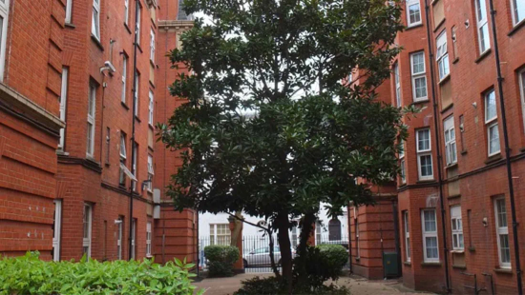
The Sutton Estate Regeneration, Chelsea
Created on 25-10-2024
Innovative aspects of the housing design/building
The Deep Energy Retrofit (DER) involves four blocks with new lifts, ground floor apartments made wheelchair accessible, 81 one-to-four-bedroom flats, double glazed windows with aluminium frames and trickle vents, and re-opening closed balconies as private outdoor spaces for residents. A ground source heat pump acts as a collective heater via 200m deep piping in 25 boreholes distributing heat to each home through individual Kensa ‘shoeboxes’. The ventilation, heating, and thermal performance were designed together to allow each strategy to complement the other: insulation depth was limited, the ground source heat pump has a certain performance, and walls were made airtight.
The landscaping includes a new communal garden, natural stone hard landscaping, and soft landscaping that directs rainwater to the garden. A play trail will wind through the estate, transforming the spaces between building entrances into inviting, people-friendly areas. These will feature new trees, attractive landscaping, and enhanced facilities for bin and bike storage. The sunken garden has been updated and is a focal point for communal activity and respite. New cycle infrastructure also aims to encourage an increase in cycling as transportation. The estate office boasts a sedum roof and will be used by maintenance staff and whenever housing officers require offices on site.
Construction characteristics, materials and processes
The DER occurred while the four buildings were unoccupied. Floor plans were amended to accommodate new lifts and a greater household mix. The construction system adds the following to existing brick masonry walls: 50mm wood fibre internal insulation; 5mm reinforced lime plaster coat; double glazed windows with timber frames, aluminium fascia, and trickle vents. Where closed balconies existed, these were opened to provide some private outdoor space. Where they did not exist, prefabricated external metal balconies were fixed to the façade.
The maintenance regeneration was retrofitted with residents in situ with external façades designed to look identical to the DER. While it was preferable not to move, this was a challenge because residents have had to live with scaffolding for almost 2 years, impacting natural light and noise. During particularly disruptive periods or vulnerabilities, residents could temporarily move into vacant apartments on site. A phased approach was taken, largely block by block, where replacement of kitchens, bathrooms, boilers, and electrics occurred simultaneously on a property-by-property basis. This may mean more tenant disruption but minimises the duration of inconvenience to each home. Window replacements are being undertaken in conjunction with the external works to each block, including roof replacement, lightning conductors, pointing and brickworks repairs, and pest control measures. This maximises utilisation of the scaffold to the block, which represents a significant part of the costs, helping to achieve better value for money overall. Improvements were also made to the communal areas, door entry systems and lifts. The phasing of the 11 occupied blocks was developed to enable the scaffold to be removed in time for the landscaping works to be carried out.
Although it was preferable to avoid any relocation, this proved challenging given that residents had to live with the presence of scaffolding for almost two years, which resulted in disruptions to their natural light and noise levels. During periods of particularly disruptive construction activity or when specific vulnerabilities were identified, residents were able to temporarily relocate to vacant apartments on site. The project was delivered in a phased manner, with each block undergoing replacement of kitchens, bathrooms, boilers, and electrics simultaneously. This approach may result in greater disruption for tenants, but it also serves to minimise the overall duration of inconvenience to each residence.
To meet Secure by Design (SBD) requirements front doors to each block will have a metal core and timber facades. Existing windowsills are at a height of 990mm. Bars at a height of 1,100mm are, therefore, added to the window internals to adhere to modern building regulations. The fence around the sunken garden will be replaced by a metal fence at a 1,100mm height.
Energy performance characteristics
The objective of the DER is to enhance energy performance, with a baseline of 208 kWh/m²/year and a predicted reduction of 38% to 111 kWh/m²/year.. The following measures have been taken to improve thermal performance: enhanced airtightness; 50mm wood fibre internal insulation; 5mm reinforced lime plaster coat; double glazed windows with timber frames, aluminium fascia, and trickle vents. A new ground source heat pump with individual ‘shoeboxes’ in each apartment facilitates low and constant heat through large, low service temperature radiators. After six years unoccupied, the DER buildings will become occupied in late 2024. Therefore, the actual improved performance is currently unknown.
The maintenance strategy improved energy performance through the following improvements: triple glazed windows with timber frames, aluminium fascia, and trickle vents; brickwork repairs to improve airtightness; adding loft insulation; and replacing boilers with new hybrid boilers.
Involvement of users and other stakeholders
The DER turned 159 flats, mostly studios and 1-2 bedrooms, into a mix of 81 one-to-four-bedroom flats accessible by lift. This new mix was chosen to meet the demographic needs of existing residents.
Residents are integral to the Sutton Estate. Clarion’s regular printed Sutton Estate newsletter, the ‘Chelsea Chat’ was distributed to all homes across the estate in the initial stages of the project and continued until 2021. All back issues are still available online. Through the pre-application design evolution process, two Design Update leaflets, plus a questionnaire, were produced to provide residents with the opportunity to engage. Six interactive events were held throughout the pre-application process, consisting of regular online residents’ workshop, a stakeholder walkabout and a public exhibition. A design steering group was generated from within the residents to discuss designs, gain feedback, and is now used to update on construction and share concerns. For example, there was concern over many households simultaneously cooking and showering at the same time, therefore the strategy was stress tested.
Communal events are also a key component to the estate’s philosophy. These include: a resident gardening club; pantomine, monthly senior lunches; trips to the seaside and other housing estates; various training events, such as media and chairing meetings; and outdoor events in the sunken garden, such a fish and chip van. Apprenticeship schemes have been implemented for gardeners, adding further social value.
Relationship to Urban Environment
Two of the street-facing blocks rent their ground floor to commercial shops and cafés. The residents have been historically integrated into the wider neighbourhood through shared amenities such as laundrettes, and a Tenants Association that previously organised neighbourhood fêtes. With rising costs, however, replacing affordable services with new amenities, the integration of Sutton Estate residents within the wider neighbourhood is diminishing (personal communication, 2024).
S.Furman. ESR2
Read more
->
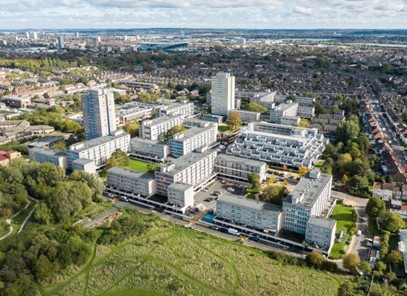
Broadwater Farm Urban Design Framework
Created on 26-07-2024
The Broadwater Farm Estate
The estate, built in the full swing of modernism, is a paragon of the movement’s defining characteristics. The building density is notably high compared to the surrounding single-family terraced houses. There is a clear separation between vehicles and pedestrians, with platforms and deck accesses. The ensemble comprises twelve high-rise precast concrete blocks and towers, which extend over a public-owned site of 18 hectares, which is unusually large by today’s standards. Facilities were also provided for residents, offering them the essential amenities. Upon completion in the early 1970s, the estate comprised 1,063 flats and was home to between 3,000 and 4,000 residents.
As was the case with numerous other modernist housing estates across the country, Broadwater Farm was significantly affected by the seminal work of Alice Coleman, Utopia on Trial (1985) on the concept of “defensible space”. Proponents of this theory posited that design had a deterministic impact on crime rates and social malaise in low-income urban communities. Although Coleman's study faced harsh criticism from academics for its questionable methodology and oversimplification of complex social problems (Cozens & Hillier, 2012; Lees & Warwick, 2022), her recommendations led to the implementation of a multi-million-pound government-funded programme for remedial works in thousands of social housing blocks nationwide; known as the DICE (Design Improvement Controlled Experiment) project. Broadwater Farm was targeted by the programme after it attracted considerable attention following the serious riots that occurred at the estate in 1985 (Stoddard, 2011). A number of initiatives were undertaken with the objective of regenerating and improving the quality of the built environment, with the earliest works beginning in 1981. Under the DICE project, a significant number of the overpass decks that connected the estate on the first floor were demolished on the grounds that they were conducive to the formation of poorly lit and isolated areas that were facilitating criminal activity and anti-social behaviour (Severs, 2010).
In the wake of the Grenfell Tower tragedy, new fire safety regulations and inspections have been introduced, resulting in two blocks of flats being deemed unfit for habitation (BBC, 2022). The Large Panel System (LPS), which was commonly used in the 1960s, has been identified as the primary cause for the demolition of the Tangmere and Northolt blocks due to the significant risk of collapse in the event of a fire. These essential repairs will be part of the largest refurbishment project ever undertaken in the estate. It will comprise a combination of retrofitting, redevelopment and infill, resulting in an increase in the number of housing units and a significant enhancement of the urban layout and public spaces across its 83,000 sq. m.
The Urban Design Framework (UDF) is a comprehensive document that sets out a series of actionable and tangible improvements for the estate. Produced by Karakusevic Carson Architects (2022) and commissioned by the Haringey Borough Council, the UDF serves as a masterplan for the ongoing regeneration of the estate. This document is the result of an extensive stakeholder involvement process. It proposes a series of five urban strategies that, taken together, provide a blueprint for holistic regeneration. These strategies account for the short, medium and long-term development of both the estate and its community.
Given the substantial size of the complex, the scale of the surrounding neighbourhood, and the intricate web of relationships within it, long-term planning holds significant importance. These aspects were emphasised through the proposed interventions that enhance the connections between the dwellings and the urban context. The impact of the estate on the surrounding area and the need for a cohesive urban landscape are addressed through designs that integrate the estate into the city fabric, rather than isolating it. The improvement plan includes the construction of new residential units through the redevelopment of the blocks earmarked for demolition and the refurbishment of the remaining blocks. The architectural firm has developed a "bank of projects," a comprehensive repository of proposed interventions arising from engagement with the community as well as a site analysis, which is organised around five core principles: streets, open spaces, ground floors, character, and homes.
Resident engagement
The inhabitants were actively involved in the creation of the UDF. A series of community engagement events, held between 2020 and 2021, provided a platform to gather the voices of residents and enabled planners to better understand their aspirations and needs, identify the key improvements required, and initiate the design process that would incorporate their views into the masterplan. This process was complemented by the establishment of the Community Design Group (CDG), formed by residents and community members who not only expressed a desire, but also demonstrated the capacity, to assume a more active role in the design process. In addition, the council has set up a website that documents and displays the schedule, events, latest news and updates on the ongoing regeneration process. This website provides comprehensive information for residents, the general public, and any interested parties seeking to gain insight into the current status of Broadwater Farm.
Placemaking strategy
In contrast to pervasive narratives about the flawed design of council estates, the spatial qualities and existing sense of belonging within the community were identified as the starting points for the placemaking strategy. The original configuration of the estate was conceived around community facilities and courtyards, which have been retained, augmented, formalised, and linked by a circuit of pedestrian and cycle paths. The deficiencies of the original design, such as the anonymous and segregated ground floor, have been addressed by establishing a network of public spaces that prioritise human scale and facilitate movement throughout the estate. These new public spaces facilitate social interaction, providing areas of activity complemented by indoor amenities and spaces for local retailers. In this way, the ground level becomes an anchor for diverse activities aimed at enhancing the sense of security.
The masterplan revolves around five principles which in turn incorporate a series of strategies:
1. Safe and Healthy Streets: The improved design shifts away from 'streets in the sky' to enhance street accessibility. It promotes intermodal transport with a new bus route into the estate and the addition of cycle lanes. The road network within the estate has been simplified to be more efficient and encourage walking. A "green" street connects key community facilities and green spaces. Overall wayfinding is enhanced through better street lighting, improved block entrances, and designated car-free areas. Part and parcel of reactivating the ground floor is creating opportunities for new activities through a redesign aimed at more efficient parking solutions to meet current needs.
2. Welcoming + Inclusive Open Spaces: Although the estate features several courtyards and open areas, residents have expressed a feeling of being in a “concrete jungle”, as noted in the community brief. The proposed improvements focused on enhancing the existing courtyards to ensure accessibility and facilitate various activities. In addition, a new community park is planned at the heart of the estate as part of the redeveloped area, designed to be a versatile and welcoming space for current and future residents alike. A hierarchy of shared and public spaces has been redesigned to create a seamless transition into and out of the estate. This seamless and unified experience of the public realm is enabled by specific elements such as play areas and seating that allow people of all ages to socialise and interact in an informal yet purposeful manner.
Workshops were conducted with specific population groups, including young women and girls or older residents, to ensure that the future estate will be as inclusive as possible. Key topics such as perceived safety in the communal areas, activities and sports facilities, as well as overall design considerations, were discussed during these sessions.
3. Ground Floors with Activity: A significant design flaw in the existing estate was the poorly lit areas adjacent to the garages that dominated the ground floor of the blocks — a common design feature in residential architecture of the time. Residents involved in the process pointed out the importance of increasing the sense of security when moving around these areas. A street-based design that activates the ground floor by enabling a greater variety of activities was central to the strategy. Alongside a clearer street layout and improved block entrances, bike racks, bin storage, and opportunities for non-residential and community uses were proposed to benefit both residents and the wider community. By repurposing areas previously used mainly for car parking into active spaces and by enhancing frontages with residential, commercial or community spaces, clear thresholds and boundaries are created to promote permeability and smooth transitions. Community facilities and local businesses are strategically located at corners and key activity nodes, facilitating passive surveillance and overlooking the public realm. The choice of materials also contributes to opening up the ground level; glazed lobbies and entrances connect indoor communal areas with adjacent outdoor spaces visually. Similarly, secondary entrances to existing blocks will be used to balance their function and prevent the creation of hidden or less frequented areas. Improved public lighting, new signage and a control system complement these strategies.
4. Broadwater Character & Scale: The architectural style known as Brutalism played a significant role in popularising the 'problem estate' narrative in Britain. This style was embraced by many of the country's modernist architects, leading to its prevalence in the social housing built during that period. Characterised by the predominant use of concrete, this style was celebrated by critic and advocate Reyner Banham for its memorable image, a clear exhibition of structure and honest expression of the material (Boughton, 2018). The monumentality and stark aesthetics of Brutalism provided an ideal setting for experimentation in the vast estates that were built during the latter half of the 20th century. These characteristics are evident in the design of Broadwater Farm.
Broadwater’s design framework acknowledges the latent potential of the existing architecture while addressing issues of materiality, building height, the links and spatial relationships between the infilled and redeveloped areas and the connection between the estate and its surroundings. The boundaries of the estate were revised to address the issue of it being perceived as an isolated entity, which was a common problem with many modernist estates. This was due to the fact that they were often of a particular size and density, which set them apart from their neighbours. In order to create a seamless transition with the surroundings, clear entrances to the estate are proposed, new materials are used that better match those of the vicinity, and a massing strategy is employed to avoid abrupt transitions in building heights.
The character of the estate was approached in a manner reminiscent of Kevin Lynch’s (1964) five elements of the city —paths, edges, districts, nodes and landmarks—, with particular emphasis on their importance in establishing a sense of place and enhancing the legibility of the urban environment. The proposal has engaged in a meticulous study of the local context, re-signifying existing elements such as the Kenley Tower, which has been retained as the tallest mass in the ensemble, in order to maintain its landmark character.
5. Good Quality Homes: The new blocks, arranged in courtyards that reflect the existing pattern of the estate, will replace the Tangmere and Northolt blocks. They will occupy a privileged position at the heart of the estate and offer an opportunity to transform the overall look of the scheme. These new blocks, complemented by infill development on nearby sites, will result in the creation of 294 new residential units, representing a net increase of 85 homes. The new dwellings, comprising three and four-bedroom family homes, will be managed by the council and rented out at social rates. A significant proportion of residents who participated in the public consultation highlighted the necessity for larger and more spacious accommodation, particularly for large families. In response to these demands, the design of the new flats incorporates larger and more flexible spaces as a key feature. Those who previously resided in the demolished blocks will be given priority for the new homes.
Furthermore, the introduction of new parks, public spaces, workspaces and a new well-being hub, which will house a doctor's surgery and other services, will help create a more active and dynamic ground floor, with activities that enhance the sense of place and welcome pedestrians. The architects have conducted an analysis of potential infill solutions to activate the ground floor, including the addition of one-bedroom flats that fit into the structural grid of the existing blocks. This in turn addresses the need to create a community that includes people of all ages and family types.
Management & Maintenance
The UDF exemplifies how regeneration projects can address current needs while allowing for future adaptations. This people-centred project fosters a sense of ownership through participation, which is crucial for the sustainability of the intervention. Stewardship is key, especially for the new collective spaces being created. Instead of a deterministic design approach, the framework considers what types of spaces can enhance the overall quality of life. It integrates social, economic, and environmental aspects that define the living and working experience in the area. These considerations are captured in the “Strategy for a Sustainable Neighbourhood.”
The bank of projects is a repository of proposed interventions within the project, illustrating the considerable interest in the long-term effects of the regeneration project and the substantial potential for future development. This section of the framework underscores the necessity for the formulation of a phased, structured and comprehensive planning and delivery strategy that allows for flexibility and input from existing and future residents. Consequently, management and maintenance are regarded as integral aspects of the design, alongside other tangible elements of the built environment.
With an approach strongly focused on creating social value and reducing the disruptive effects of regeneration. The architects have worked with the community to develop a masterplan that emphasises the use of existing assets, minimises demolition and establishes a hierarchy of priorities to maximise the positive impact in the long term.
L.Ricaurte. ESR15
Read more
->
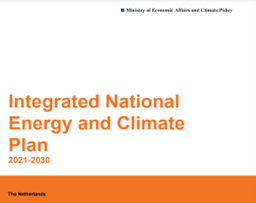
Housing retrofit subsidies in the Netherlands
Created on 20-11-2024
In Europe, the push for energy-efficient housing has led to widespread use of financial incentives such as grants, loans, and tax rebates to encourage homeowners to undertake retrofits. These measures aim to reduce energy consumption and improve the environmental performance of residential buildings. Governments across the continent have adopted various programs to support these efforts, offering significant financial aid to make energy-saving improvements more accessible to homeowners. In addition to subsidies, some countries implement energy taxes to further promote efficiency and fund sustainability initiatives. At the European Union level, comprehensive strategies are being developed to enhance the energy efficiency of buildings, including proposals for new regulatory frameworks and financial incentives. This multi-faceted approach reflects a growing recognition of the importance of sustainable housing in achieving broader environmental and economic goals.
Subsidisation of housing retrofit, through grants and loans, as well as tax rebates are commonly used across Europe to incentivise the energy-efficient retrofit of the housing stock (Castellazzi et al., 2019). Following this trend, the Dutch government has put in place a series of grants and subsidised loans to incentivise retrofit. First, the “Subsidie Energiebesparing Eigen Huis” is a grant programme covering up to 50% of retrofit costs when at least two energy-saving measures improving EPC levels have been implemented. Dutch homeowners can also apply for the Investment Grant for Sustainable Energy Savings (ISDE) in the case of single measures such as solar boilers or heat pumps (Ministry of Economic Affairs and Climate Policy, 2019). Since 2022, 0% interest loans are also available to low-income households from the National Heat Fund.
On the stick side of retrofit incentivation, the Netherlands implements a regressive form of carbon taxation on individual households (Maier & Ricci, 2024). Research by the Dutch National Bank has also alluded to the strong impact of energy taxation on lower incomes and the inelasticity of energy consumption. Havlinova et al. (2022) have found that the introduction of stronger forms of energy taxation in heated energy markets can impinge on lower incomes resulting in regressive distributional impacts. At the EU level, the Renovation Wave is actively promoting this approach to housing retrofit through its proposal to include buildings in the Emissions Trading Scheme (ETS) together with the implementation of retrofit subsidies(2003/87/EC). As a result, while owner-occupied housing is undertaxed, the tax burden on energy consumption at the household level is poised to increase.
Retrofit subsidies usually come to join fiscal systems favouring owner occupation. These forms of direct subsidisation of housing retrofit coalesce with increases in the fiscal burden on energy consumption. According to Haffner & Heylen (2011), the housing taxation structure favours owner-occupation with a mortgage through large deductions in income tax. In the Netherlands, imputed rent, the main form of housing taxation is calculated on the basis of a notional rent value and then added onto box 1 which comprises labour income. All other income from investments is taxed under box 3 at a different rate. Haffner & Heylen (2011) have analysed the lack of tax neutrality in this system and propose to include the taxation of housing assets under box 3 as a tax-neutral benchmark. In the context of housing retrofit, the favourable fiscal treatment of homeownership comes to join generous subsidies for owner-occupied housing retrofit with no maximum income threshold offered by the Dutch government. A green tax is a viable alternative to incentivise retrofit in a more progressive manner.
The Dutch approach to incentivising housing retrofits exemplifies a broader European commitment to enhancing energy efficiency through a combination of financial incentives and regulatory measures. While generous subsidies and tax incentives significantly benefit homeowners, particularly those with mortgages, the regressive nature of energy taxation presents challenges for lower-income households.
Research indicates that increased energy taxation disproportionately impacts these households, underscoring the need for more progressive solutions. The EU’s Retrofit Wave, along with the proposed inclusion of buildings in the ETS, reflects an ongoing effort to balance these measures. In the context of housing retrofits, a shift towards green taxes could provide a more equitable framework, ensuring that the financial burden and benefits of energy-efficient improvements are more evenly distributed across different income groups.
(This text is an excerpt from : Fernández, A., Haffner, M. & Elsinga, M. Subsidies or green taxes? Evaluating the distributional effects of housing renovation policies among Dutch households. J Hous and the Built Environ (2024). https://doi.org/10.1007/s10901-024-10118-5 )
M.Elsinga. Supervisor, M.Haffner. Supervisor, A.Fernandez. ESR12
Read more
->








